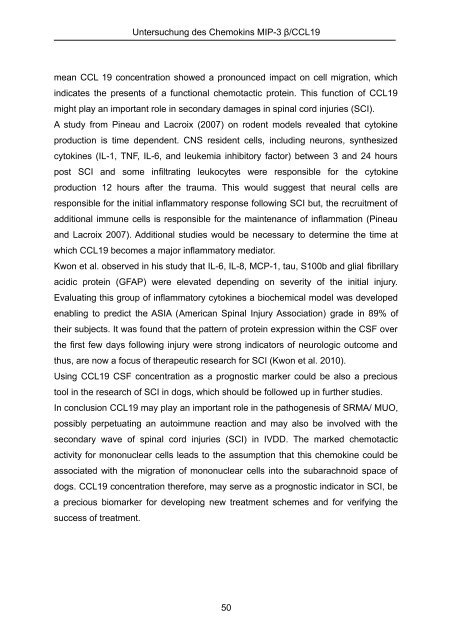TiHo Bibliothek elib - Tierärztliche Hochschule Hannover
TiHo Bibliothek elib - Tierärztliche Hochschule Hannover
TiHo Bibliothek elib - Tierärztliche Hochschule Hannover
Create successful ePaper yourself
Turn your PDF publications into a flip-book with our unique Google optimized e-Paper software.
Untersuchung des Chemokins MIP-3 β/CCL19<br />
mean CCL 19 concentration showed a pronounced impact on cell migration, which<br />
indicates the presents of a functional chemotactic protein. This function of CCL19<br />
might play an important role in secondary damages in spinal cord injuries (SCI).<br />
A study from Pineau and Lacroix (2007) on rodent models revealed that cytokine<br />
production is time dependent. CNS resident cells, including neurons, synthesized<br />
cytokines (IL-1, TNF, IL-6, and leukemia inhibitory factor) between 3 and 24 hours<br />
post SCI and some infiltrating leukocytes were responsible for the cytokine<br />
production 12 hours after the trauma. This would suggest that neural cells are<br />
responsible for the initial inflammatory response following SCI but, the recruitment of<br />
additional immune cells is responsible for the maintenance of inflammation (Pineau<br />
and Lacroix 2007). Additional studies would be necessary to determine the time at<br />
which CCL19 becomes a major inflammatory mediator.<br />
Kwon et al. observed in his study that IL-6, IL-8, MCP-1, tau, S100b and glial fibrillary<br />
acidic protein (GFAP) were elevated depending on severity of the initial injury.<br />
Evaluating this group of inflammatory cytokines a biochemical model was developed<br />
enabling to predict the ASIA (American Spinal Injury Association) grade in 89% of<br />
their subjects. It was found that the pattern of protein expression within the CSF over<br />
the first few days following injury were strong indicators of neurologic outcome and<br />
thus, are now a focus of therapeutic research for SCI (Kwon et al. 2010).<br />
Using CCL19 CSF concentration as a prognostic marker could be also a precious<br />
tool in the research of SCI in dogs, which should be followed up in further studies.<br />
In conclusion CCL19 may play an important role in the pathogenesis of SRMA/ MUO,<br />
possibly perpetuating an autoimmune reaction and may also be involved with the<br />
secondary wave of spinal cord injuries (SCI) in IVDD. The marked chemotactic<br />
activity for mononuclear cells leads to the assumption that this chemokine could be<br />
associated with the migration of mononuclear cells into the subarachnoid space of<br />
dogs. CCL19 concentration therefore, may serve as a prognostic indicator in SCI, be<br />
a precious biomarker for developing new treatment schemes and for verifying the<br />
success of treatment.<br />
50










![Tmnsudation.] - TiHo Bibliothek elib](https://img.yumpu.com/23369022/1/174x260/tmnsudation-tiho-bibliothek-elib.jpg?quality=85)





